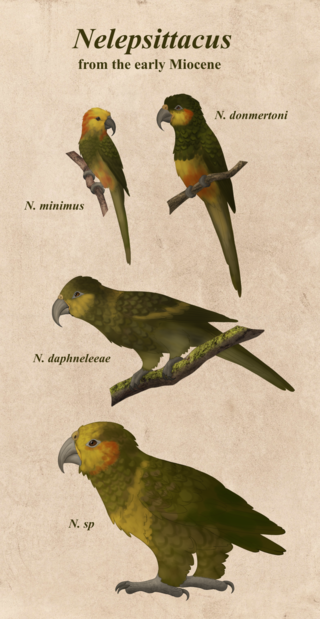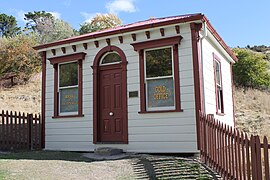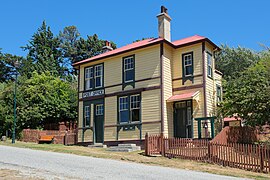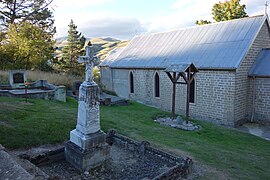
Alexandra is a town in the Central Otago district of the South Island of New Zealand. It is on the banks of the Clutha River, on State Highway 8, 188 kilometres (117 mi) by road from Dunedin and 33 kilometres (21 mi) south of Cromwell. The nearest towns to Alexandra via state highway 8 are Clyde seven kilometres to the northwest and Roxburgh forty kilometres to the south. State highway 85 also connects Alexandra to Omakau, Lauder, Oturehua, Ranfurly and on to Palmerston on the East Otago coast.

The Manuherikia River is located in Otago in the South Island of New Zealand. It rises in the far north of the Maniototo, with the West Branch draining the eastern side of the St Bathans Range, and the East Branch draining the western flanks of the Hawkdun Range. The river continues southwest through the wide Manuherikia Valley to its confluence with the Clutha River at Alexandra. During the 1860s the Manuherikia was one of the centres of the Central Otago Gold Rush.
The Saint Bathans mammal is a currently unnamed extinct primitive mammal from the Early Miocene of New Zealand. A member of the Saint Bathans fauna, it is notable for being a late-surviving "archaic" mammal species, neither a placental nor a marsupial. It also provides evidence that flightless fully terrestrial mammals did in fact once live in Zealandia. This is in contrast to modern New Zealand, where bats, cetaceans and seals are the only non-introduced mammals in the otherwise bird-dominated faunas.
The Gold Field Towns electorate was a 19th-century parliamentary electorate in the Otago region of New Zealand. It was the second gold mining electorate in Otago, one of three special interest constituencies created to meet the needs of gold miners; the third electorate was located on the West Coast. The Gold Field Towns electorate was in 1865, with the first elections in the following year, and it returned one member. All three of these special interest electorates were abolished in 1870. A unique feature of the Gold Field Towns electorate was that it covered ten separate towns within the area of the Gold Fields, which in turn was overlaid of a number of general electorates in the Otago area. Voting was open to those who had held a mining license for some time. As such, suffrage was more relaxed than elsewhere in New Zealand, as voting was otherwise tied to property ownership. Another feature unique to the gold mining electorates was that no electoral rolls were prepared, but voting could be done upon showing a complying miner's license.

Nelepsittacus is a genus of extinct New Zealand parrots that is closely related to the genus Nestor. It consists of four species, of which three have been named so far. The species are all known from the early Miocene Saint Bathans Fauna from the Lower Bannockburn Formation in Otago in New Zealand.
Rupephaps taketake, also referred to as the Saint Bathans pigeon, is an extinct species of pigeon from the Miocene of New Zealand. It is the first species of columbid to be described from pre-Pliocene fossil deposits in the Australasian region.

The St Bathans fauna is found in the lower Bannockburn Formation of the Manuherikia Group of Central Otago, in the South Island of New Zealand. It comprises a suite of fossilised prehistoric animals from the late Early Miocene (Altonian) period, with an age range of 19–16 million years ago.
Manuherikia is a genus of extinct species of ducks from the Miocene of New Zealand. It was described from fossil material of the Saint Bathans Fauna, in the lower Bannockburn Formation of the Manuherikia Group, found by the Manuherikia River in the Central Otago region of the South Island. The genus name comes from the name of the geological formation in which the fossils were found and, ultimately, from the Manuherikia River and its valley.
Miotadorna is a genus of extinct tadornine ducks from the Miocene of New Zealand. It contains two species, M. sanctibathansi, and M. catrionae.
Dunstanetta johnstoneorum is a genus and species of extinct duck from the Miocene of New Zealand. It was described from fossil material collected from a Saint Bathans Fauna site on Home Hills Station, in the lower Bannockburn Formation of the Manuherikia Group, in the Manuherikia River valley in the Central Otago region of the South Island. The genus name refers to the Dunstan Range, the mountains of which overlook the fossil site. The specific epithet honours Ann and Euan Johnstone of Home Hills Station.
Matanas enrighti is an extinct duck from the Miocene of New Zealand. It was described from fossil material collected from a Saint Bathans Fauna site near Mata Creek, in the lower Bannockburn Formation of the Manuherikia Group, in the Manuherikia River valley in the Central Otago region of the South Island.

Pikaihao bartlei, also referred to as Bartle's bittern or the Saint Bathans bittern, is a genus and species of prehistoric small bittern from the Early Miocene of New Zealand. It was described in 2013 from fossil material found in the Saint Bathans Fauna of the Bannockburn Formation, at Home Hills Station in the Manuherikia River valley of Otago, South Island. It was a contemporary of the much larger Saint Bathans heron, remains of which have been found in the same sediments. The genus name Pikaihao comes from the Māori pi and kaihao (“fisherman”). The specific epithet honours Sandy Bartle, Curator of Birds at the Museum of New Zealand Te Papa Tongarewa from 1976 to 2009.

The Manuherikia Group is a fluvial-lacustrine sedimentary fill in the Central Otago area of New Zealand, at the site of the prehistoric Lake Manuherikia. The area consists of a valley and ridge topography, with a series of schist-greywacke mountains at roughly ninety degrees to each other. The Manuherika Group occurs in the current basins, and occasionally on the mountains themselves.
Lake Manuherikia was a prehistoric lake which once stretched over some 5,600 square kilometres (2,200 sq mi) in what is now inland Otago in New Zealand's South Island. It stretched from Bannockburn and the Nevis valley in the west to Naseby in the east, and from the Waitaki valley in the north to Ranfurly in the south, including much of the area now referred to as the Maniototo. The lake existed from around 19 to 16 million years ago during the Miocene epoch, at which point New Zealand was significantly warmer than the present.
Vulcanops jennyworthyae is an extinct species of bat that lived during the Miocene in New Zealand, a large burrowing microchiropteran that probably ate arthropods and plant material around twenty million years before present. It is the type and only described species of the genus Vulcanops.

Heracles inexpectatus is a giant fossil parrot species from New Zealand, assigned to a monotypic genus Heracles, that lived during the early Miocene approximately 16 to 19 million years ago. The species was described from two tibiotarsus fossils discovered in 2008 at Saint Bathans, Otago, New Zealand. It is believed that the species stood up to 90 cm tall and weighed approximately 7 kg (15 lb). Initial analysis suggests that this parrot is from the order Psittaciformes and from the superfamily Strigopoidea, which consists of three confirmed primitive genera of parrots: Nestor, Strigops (Kākāpō) and the fossil Nelepsittacus. It may have been the ancestor of the kākāpō.

Zealandornis is an extinct genus of zealandornithid bird from the early Miocene Bannockburn Formation of Otago, New Zealand. The genus contains a single species, Zealandornis relictus, known from a distal right humerus.
Notochen, also called the Bannockburn swan, is an extinct genus of anatid bird from the Early Miocene Bannockburn Formation of Otago, New Zealand. The genus contains a single species, Notochen bannockburnensis, known from various fossil material.

Cambrians, or Cambrian, formerly known as Dunstan Creek and Welshman's Gully, is a small rural settlement in the Manuherikia Valley, Central Otago, New Zealand.

















